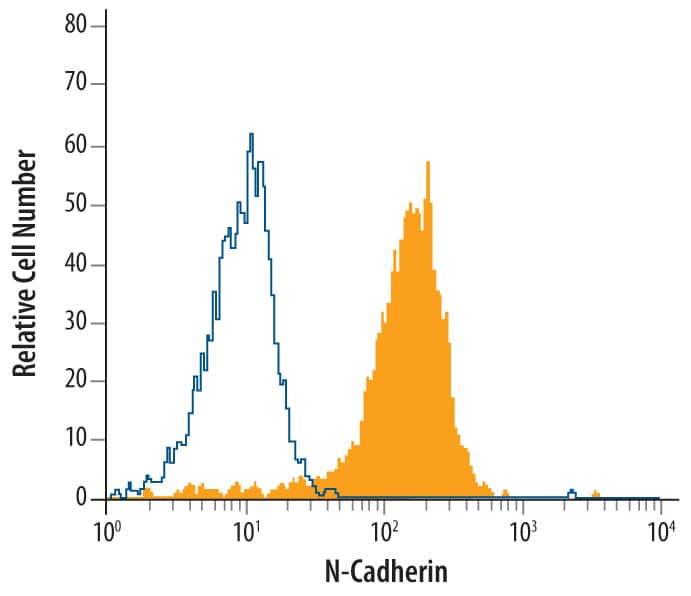Human N-Cadherin Antibody
R&D Systems, part of Bio-Techne | Catalog # MAB13882


Key Product Details
Species Reactivity
Applications
Label
Antibody Source
Product Specifications
Immunogen
Ser26-Arg159
Accession # P19022
Specificity
Clonality
Host
Isotype
Scientific Data Images for Human N-Cadherin Antibody
Detection of N-Cadherin in HeLa Human Cell Line by Flow Cytometry.
HeLa human cervical epithelial carcinoma cell line was stained with Mouse Anti-Human N-Cadherin Monoclonal Antibody (Catalog # MAB13882, filled histogram) or isotype control antibody mouse IgM (open histogram), followed by Phycoerythrin-conjugated Anti-Mouse IgM Secondary Antibody (Catalog # F0116).Applications for Human N-Cadherin Antibody
CyTOF-ready
Flow Cytometry
Sample: HeLa human cervical epithelial carcinoma cell line
Formulation, Preparation, and Storage
Purification
Reconstitution
Formulation
Shipping
Stability & Storage
- 12 months from date of receipt, -20 to -70 °C as supplied.
- 1 month, 2 to 8 °C under sterile conditions after reconstitution.
- 6 months, -20 to -70 °C under sterile conditions after reconstitution.
Background: N-Cadherin
N‑Cadherin (Neural Cadherin; also CD325 and Cadherin-2) is a 130‑135 kDa member of the "classical" (or type I) cadherin subfamily, cadherin superfamily of proteins. It is expressed on multiple cell types, including neurons, fibroblasts, Schwann cells, endothelial cells and hepatic stellate cells. N‑Cadherin mediates homotypic binding, either in cis (same cell) or trans (adjacent cell). proN‑Cadherin is expressed as an 881 amino acid (aa) type I transmembrane glycoprotein. It may be initially inserted into the ER, where the 15‑20 kDa prodomain (aa 26‑159) is cleaved by proprotein convertase, and the mature molecule is transported to the surface. Alternatively, on neurons, proN‑Cadherin may first appear on the surface, with cleavage occurring at the time of synaptogenesis. Cleavage appears necessary for homophilic interaction as presence of the prodomain is suggested to negatively regulate oligomer formation. Over the entire prodomain, the human N‑Cadherin proregion shares 87% aa identity with the mouse N‑Cadherin proregion.
Long Name
Alternate Names
Gene Symbol
UniProt
Additional N-Cadherin Products
Product Documents for Human N-Cadherin Antibody
Product Specific Notices for Human N-Cadherin Antibody
For research use only